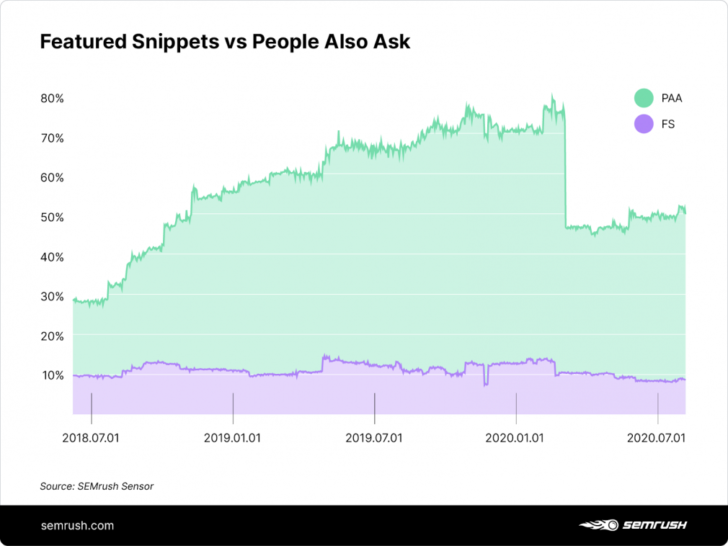30-second summary:
- Zero click search presents advertisers with the opportunity to pro-long budgets during periods when the paid search landscape is hypercompetitive
- Brands can cash in on zero click searches for the organic element of their overall search strategy to gain visibility and drive conversions
- Barilla Group’s global digital & search marketing manager, Nitin Manhar Dhamelia advises on zero click search optimization and measurement
Historic context
Back in 1998 when Google was founded, it served 10,000 searches per day and by 2012 it was 3,500,000,000 searches per day. And in 2021, search volumes continue to explode with Google serving around 5,600,000,000 searches globally per day.

Its success in becoming a transitive verb was borne when Google tasked itself with bringing order to the chaos of the world’s knowledge. It knew that to achieve this magnitude of top-of-mind awareness, the key would be to create a window to the web that was inclusive, accessible, and easy to understand for the general population; it knew that inclusivity would accelerate adoption. Even today, the search giant is always working on improving the consumers’ search experience and 2021 saw several key algorithm updates roll out – passage ranking, page experience, page titles, MUM, mobile-first indexing, and more.
Not too far ahead in the future, Google is going to make it even easier for consumers to access information about brands. But why?
Micro funnels
Because people visit Google in key decision-making moments along the buyer journey – essentially, each Search session can be deemed a micro funnel. In fact, after the pandemic, there is no undoing the great reset. Nearly, 15 percent of Google search queries Google attended were first of their kind. And 81 percent of consumers discovered new brands online during the pandemic.
“There isn’t a world where people revert back to their 2019 behaviours, and part of that is now a part of their comfort zones.” – Corie Barry, CEO, Best Buy
Google’s own recent retail report identified four key consumer insights:
- Dynamic demand: People’s buying patterns will continue to change in response to unpredictable times
- Digital inspiration: People will use the internet to be inspired
- Convenience: People will prioritize convenience while shopping
- Supportive spending: People will be more mindful of how and where they spend their dollars with “values” playing a major influencer
Even though less favored by advertisers, zero click searches are pockets of opportunity for brands to focus on as part of their branded search strategy.
With great power comes great responsibility
With its always-on innovation focus, Google is constantly expected to eclipse itself (for the better) and the way it aims to achieve that is by presenting information in ever more easy-to-digest consumer-friendly formats.
Its solution? Bringing convenience and comfort to their searcher’s online journey with zero click search. This means redesigning the search experience to align with a lucid consumer journey, which in some cases implies that – the journey both starts and ends in Google, and without a single click in the search results:

In terms of how this translates into volumes of searches, take a look at the data from an industry study below:

What does this mean for brands?
In my own research the split of traffic between the core search marketing channels for a keyword that has a “need” intent, calculates to:
- Paid: 6.5 percent
- Organic (above the fold): 31.5 percent
- Organic (below the fold): two percent
- Zero Click Searches: 60 percent
Extraordinarily, the last number isn’t too far off an original 2020 study that was made of a sample size that is far greater than most brand marketers might have immediate access to.
However, when smaller, localized in-house studies surface very similar results it drives the conversation forward into where we need to focus a proportion of our overall search budgets: creating data-driven content that contributes to adding value and top-of-mind awareness (TOMA) to consumers.
Tips for brands to optimize and measure zero click search
The people also ask (PAA) feature in Google (essentially website content derived FAQs in Search results) are around six times more likely to appear in a search results page versus featured snippets. And therefore, PAA should not be underestimated as a branding tool. So the first tip is to create editorial content that resides on your website and optimize for PAA – using long-tail search data.
And the second tip is to optimize your content for featured snippets across brand and partner websites – your keyword traffic or search traffic insights could help prioritize this activity internally.
Another interesting insight that stood out was – regardless of the industry, most “big” brands will trigger a PAA.

Measuring zero-click performance
Gauging the impact of zero click search remains a frequently asked question itself and a continued enigma that has hampered brands from focusing on this highly important search facet. These are some valuable avenues for search marketers to track the zero click search features’ performance:
1. Understand relativity
Understand the relationship between impression volume and average ranking for a target keyword(s) in the Google search console to create insights into where branded content can trigger a zero click search result.
2. Track soft metrics
This is where the soft metric shines – so by focusing on zero click SERP features for brand vs competitor domains, it’s possible to create an index to track the outcomes and evolution of a soft metric such as ‘share of intent’. This will help you grow product or service awareness/consideration via the zero click search element of your Search Strategy.
Piecing all this information and tailoring it to your brand will positively add a new dimension to your search marketing strategy.
Nitin Manhar Dhamelia is the global digital & search marketing manager at Barilla Group. Nitin has a 15-year track record of global B2B/B2C team management, governance, commercial experience, across Americas, EMEA, APAC.
Subscribe to the Search Engine Watch newsletter for insights on SEO, the search landscape, search marketing, digital marketing, leadership, podcasts, and more.
Join the conversation with us on LinkedIn and Twitter.







